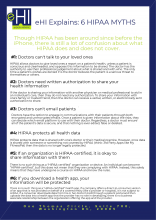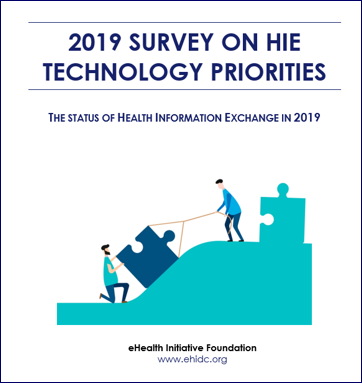Topic intro description here. Limited to 145 characters. Topic intro description here. Limited to 145 characters. Topic intro description here.
CRISP is Pleased to Submit Comments to the Office of the National Coordinator for Health Information Technology (ONC) on the Proposed Rule 21st Century Cures Act
CRISP supports the proposed rule and strongly supports the direction ONC is taking with regards to interoperability.
eHI Explains: HIPAA

HIPAA Myths

The new bipartisan House bill to stop surprise medical bills, explained
The new bipartisan House bill to stop surprise medical bills, explained
Congress is ramping up its push to stop surprise medical bills.
Reps. Frank Pallone (D-NJ) and Greg Walden (R-OR), the top Democrat and Republican on the House Energy and Commerce Committee, have jointly released a draft bill that would prevent patients from facing unexpected charges after they go to the emergency room or receive other non-emergency medical care.
The draft legislation, shared exclusively with Vox, is the most robust proposal yet as lawmakers from both parties and President Donald Trump say they want to end surprise billing. The plan would prohibit surprise charges not only for emergency care when a patient ends up at a hospital that is out of their insurance plan’s network, but also for non-emergency care when the facility might be in network but certain providers are not.
The full Vox article can be viewed at this link.
2019 Survey on HIE Technology Priorities
Based on results from eHI’s 2019 Survey on HIE Technology Priorities, this report examines HIE perspectives on:
- Adoption of new technology
- Integrating clinical and claims data
- Types of data being exchanged
- Business drivers and priorities
- Challenges associated with the aforementioned
For almost two decades, eHealth Initiative and Foundation (eHI) has monitored the state of health information exchanges. Healthcare is experiencing rapid evolution with the emergence of new technologies and payment models. In response, both the public and private sectors are seeking ways to improve the quality and safety of care, resulting in a growing momentum to improve interoperability. Organizations like health information exchanges (HIEs) and health information networks (HINs) act as a source of valuable information and services, making the continued evaluation of their challenges, opportunities, and priorities important.
Background on Health Information Exchanges
As the name implies, HIEs provide technology and services to help their stakeholders exchange electronic health information. HIEs do not provide healthcare services. Instead, they impact the quality and cost of care, and ultimately outcomes, by sharing patient health data across organizations within a region, community, or hospital system.
Numerous trends that will drive the adoption of new technologies, the ability to exchange various data types, and the direction of HIE priorities are already evident in 2019. The healthcare industry is in the process of adopting performance-based funding models in place of more traditional reimbursement-based models. Industry is also facing an influx of value-based care initiatives; growing support for application programming interface (API) based interoperability standards, such as HL7®’s Fast Healthcare Interoperability Resources (FHIR®); complex laws for sharing non-traditional types of data; and the push for nationwide exchange of electronic health information across disparate HINs. As new payment models emerge, healthcare stakeholders are increasingly seeking out new types of data that will give a wider perspective of a patient’s health and social experiences.
An HIE’s ability to integrate data enables and supports value-based care. Stakeholders can monitor their quality and cost of care, leading to improvements in care quality and care coordination, and eventually, cost savings. However, not all HIEs have the ability to integrate the many types of data necessary to enable and support value-based care and cost-lowering activities. HIE capabilities may be limited for a variety of reasons, including technical functions, costs, competing priorities, and issues around ownership and control of the data by stakeholder organizations participating in the HIE.
HHS To Implement Pay-For-Performance Models For Primary Care Practices Serving Medicare
HHS To Implement Pay-For-Performance Models For Primary Care Practices Serving Medicare
Two weeks ago, the Department of Human and Health Services (HHS) unveiledthe "Primary Cares Initiative," a program that aims to "reduce administrative burdens" and enable primary care physicians to earn "performance-based payments" if they deliver care to Medicare patients that meets certain targets and decreases downstream healthcare costs.
CMS has posted a request for applications for the first cohort of primary care practices. The program is intended to go into effect January 2020 and continue for five years.
It is hoped that if the Primary Cares Initiative is successful in Medicare, state Medicaid programs and commercial payers will follow suit. The ultimate purpose of the initiative, according to the Director of HHS, Alex Azar, is to move primary care from a fee-for-service to a value-based system, predicated on paying for healthcare outcomes rather than numbers of procedures.
The full Forbes article can be viewed at this link.
Summary of Commerce Committee Hearing: Consumer Perspectives
The Senate Committee on Commerce, Science and Transportation convened a May 1 hearing “Consumer Perspectives: Policy Principles for a Federal Data Privacy Framework”. This is an important issue for eHI and its members. Key highlights are below, along with links to witness testimony.
Healthix Template for Qualified Service Organization Agreement (QSOA)
A Qualified Service Organization Agreement (QSOA) is a two-way agreement between a Part 2 program and the entity providing the service, for example a lab. The QSOA authorizes communication only between the Part 2 program and QSO.
This template was provided by Healthix, a NY HIE that presented on best practices of sharing sensitive PHI from 42CFR Part 2 Programs on eHI's April 30, 2019 webinar.
What Genetic Testing Teaches About Long-Term Predictive Health Analytics Regulation
What Genetic Testing Teaches About Long-Term Predictive Health Analytics Regulation
The ever-growing phenomenon of predictive health analytics is generating significant excitement, hope for improved health outcomes, and potential for new revenues. Researchers are developing algorithms to predict suicide, heart disease, stroke, diabetes, cognitive decline, future opioid abuse, and other ailments. The researchers include not only medical experts, but also commercial enterprises such as Facebook and LexisNexis, who may profit from the work considerably. This Article focuses on long-term disease predictions (predictions regarding future illnesses), which have received surprisingly little attention in the legal and ethical literature. It compares the robust academic and policy debates and legal interventions that followed the emergence of genetic testing to the relatively anemic reaction to predictions produced by artificial intelligence and other predictive methods. The paper argues that like genetic testing, predictive health analytics raise significant concerns about psychological harm, privacy breaches, discrimination, and the meaning and accuracy of predictions. Consequently, as alluring as the new predictive technologies are, they require careful consideration and thoughtful safeguards. These include changes to the HIPAA Privacy and Security Rules and the Americans with Disabilities Act, careful oversight mechanisms, and self-regulation by health care providers. Ignoring the hazards of long-term predictive health analytics and failing to provide data subjects with appropriate rights and protections would be a grave mistake.
The full article can be downloaded below.
Revealing the secret prices insurers pay can save health care
Revealing the secret prices insurers pay can save health care
A bold proposal to publish tightly held secrets about health care prices could unleash the power of markets to lower health care costs.
The Department of Health and Human Services has released a request for information on a proposal to create public access to real price information in health care under the regulatory framework of the Health Insurance Portability and Accountability Act (HIPAA). Unlike the mandate earlier this year from the Centers for Medicare and Medicaid Services that requires hospitals to publish their so-called chargemaster prices, the HHS proposal would shed light on the secret negotiated prices insurance companies pay.
Making these prices public would infuse much-needed competition into health care’s bloated $3.5 trillion market.
The full STAT article can be viewed at this link.

